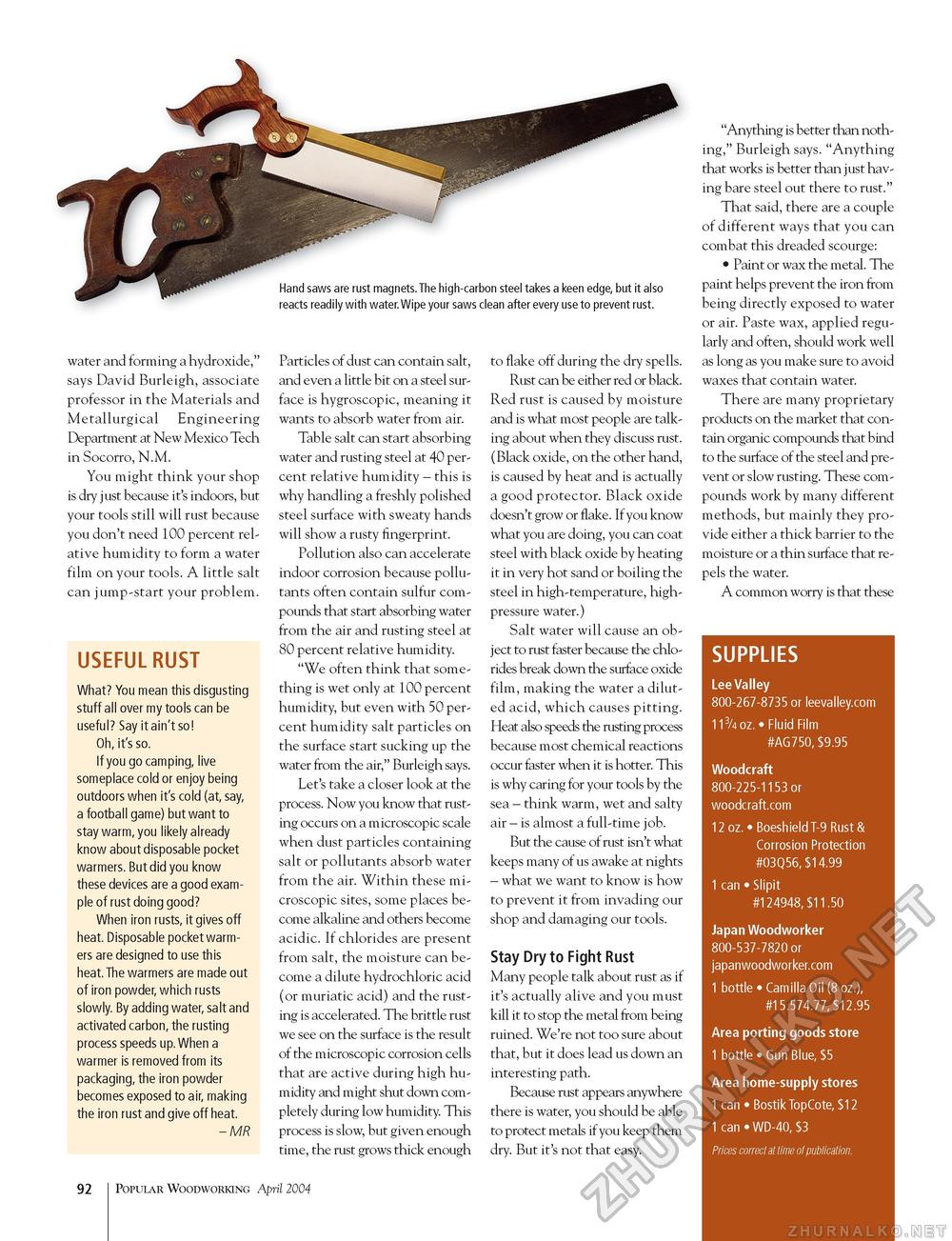Popular Woodworking 2004-04 № 140, страница 95
water and forming a hydroxide," says David Burleigh, associate professor in the Materials and Metallurgical Engineering Department at New Mexico Tech in Socorro, N.M. You might think your shop is dry just because it's indoors, but your tools still will rust because you don't need 100 percent relative humidity to form a water film on your tools. A little salt can jump-start your problem. Particles of dust can contain salt, and even a little bit on a steel surface is hygroscopic, meaning it wants to absorb water from air. Table salt can start absorbing water and rusting steel at 40 percent relative humidity - this is why handling a freshly polished steel surface with sweaty hands will show a rusty fingerprint. Pollution also can accelerate indoor corrosion because pollutants often contain sulfur compounds that start absorbing water from the air and rusting steel at 80 percent relative humidity. "We often think that something is wet only at 100 percent humidity, but even with 50 percent humidity salt particles on the surface start sucking up the water from the air," Burleigh says. Let's take a closer look at the process. Now you know that rusting occurs on a microscopic scale when dust particles containing salt or pollutants absorb water from the air. Within these microscopic sites, some places become alkaline and others become acidic. If chlorides are present from salt, the moisture can become a dilute hydrochloric acid (or muriatic acid) and the rusting is accelerated. The brittle rust we see on the surface is the result of the microscopic corrosion cells that are active during high humidity and might shut down completely during low humidity. This process is slow, but given enough time, the rust grows thick enough to flake off during the dry spells. Rust can be either red or black. Red rust is caused by moisture and is what most people are talking about when they discuss rust. (Black oxide, on the other hand, is caused by heat and is actually a good protector. Black oxide doesn't grow or flake. If you know what you are doing, you can coat steel with black oxide by heating it in very hot sand or boiling the steel in high-temperature, high-pressure water.) Salt water will cause an object to rust faster because the chlorides break down the surface oxide film, making the water a diluted acid, which causes pitting. Heat also speeds the rusting process because most chemical reactions occur faster when it is hotter. This is why caring for your tools by the sea - think warm, wet and salty air - is almost a full-time job. But the cause of rust isn't what keeps many of us awake at nights - what we want to know is how to prevent it from invading our shop and damaging our tools. Stay Dry to Fight Rust Many people talk about rust as if it's actually alive and you must kill it to stop the metal from being ruined. We're not too sure about that, but it does lead us down an interesting path. Because rust appears anywhere there is water, you should be able to protect metals if you keep them dry. But it's not that easy. "Anything is better than nothing," Burleigh says. "Anything that works is better than just having bare steel out there to rust." That said, there are a couple of different ways that you can combat this dreaded scourge: • Paint or wax the metal. The paint helps prevent the iron from being directly exposed to water or air. Paste wax, applied regularly and often, should work well as long as you make sure to avoid waxes that contain water. There are many proprietary products on the market that contain organic compounds that bind to the surface of the steel and prevent or slow rusting. These compounds work by many different methods, but mainly they provide either a thick barrier to the moisture or a thin surface that repels the water. A common worry is that these SUPPLIES Lee Valley 800-267-8735 or leevalley.com 113/4 0z. • Fluid Film #AG750, $9.95 Woodcraft 800-225-1153 or woodcraft.com 12 oz. • Boeshield T-9 Rust & Corrosion Protection #03Q56, $14.99 1 can • Slipit #124948, $11.50 Japan Woodworker 800-537-7820 or japanwoodworker.com 1 bottle • Camilla Oil (8 oz.), #1 5.574.77, $12.95 Area porting goods store 1 bottle • Gun Blue, $5 Area home-supply stores 1 can • Bostik TopCote, $12 1 can • WD-40, $3 Prices correct at time of publication. USEFUL RUST What? You mean this disgusting stuff all over my tools can be useful? Say it ain't so! Oh, it's so. If you go camping, live someplace cold or enjoy being outdoors when it's cold (at, say, a football game) but want to stay warm, you likely already know about disposable pocket warmers. But did you know these devices are a good example of rust doing good? When iron rusts, it gives off heat. Disposable pocket warmers are designed to use this heat. The warmers are made out of iron powder, which rusts slowly. By adding water, salt and activated carbon, the rusting process speeds up. When a warmer is removed from its packaging, the iron powder becomes exposed to air, making the iron rust and give off heat. - MR 92 Popular Woodworking April 2004 |








